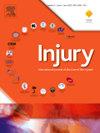创伤患者生命体征异常的发生率、严重程度和变化:基于全国人口的分析。
IF 2
3区 医学
Q3 CRITICAL CARE MEDICINE
Injury-International Journal of the Care of the Injured
Pub Date : 2025-01-01
DOI:10.1016/j.injury.2024.111884
引用次数: 0
摘要
背景:在创伤病人护理的早期阶段,生理标准被用来评估潜在的损伤严重程度。很少有研究在全国范围内描述生命体征的异常程度以及这些异常的不同组合。本研究旨在确定创伤患者的生理异常,并描述院前和急诊科(ED)环境下异常的不同组合和变化:方法:对挪威创伤登记处(NTR)15年1月1日至18年12月31日期间的数据进行评估,了解异常生理变量的发生率和特征。主要结果是通气不足(呼吸频率[RR]<10次/分)、通气过度(呼吸频率[RR]>29次/分)、低血压(收缩压[SBP]<90毫米汞柱)和意识水平下降(格拉斯哥昏迷量表[GCS]<13)的发生率:共纳入 24,482 名患者。在院前阶段,RR、SBP 和 GCS 的记录值分别为 77.6%、78.5% 和 81.9%,在急诊室的相应百分比分别为 95.5%、99.2% 和 98.6%。在院前阶段,3615 名(14.8%)患者至少有一项生命体征异常,而在急诊室,相应的数字为 3616 名(14.8%)患者。最常见的组合是 GCS 低和过度通气。从院前阶段到急诊室,分别有3.9%、1.2%和1.9%的患者出现RR、SBP和GCS的RTS评分恶化。30 天内的总死亡率为 3.1%(n=752)。其中,60.8%的患者生命体征异常,GCS下降最为普遍(61.3%):结论:大多数创伤患者的生命体征正常。结论:大多数创伤患者的生命体征正常,根据 RTS 评分,院前阶段和急诊室之间的 RR、SBP 和 GCS 几乎没有恶化。最常见的异常是 GCS 偏低,在 30 天内死亡的患者中比例较高。本文章由计算机程序翻译,如有差异,请以英文原文为准。
Incidence, severity and changes of abnormal vital signs in trauma patients: A national population-based analysis
Background
Physiological criteria are used to assess the potential severity of injury in the early phase of a trauma patient's care trajectory. Few studies have described the extent of abnormality in vital signs and different combinations of these at a national level. Aim of the study was to identify physiologic abnormalities in trauma patients and describe different combinations of abnormalities and changes between the pre-hospital and emergency department (ED) settings.
Method
Norwegian Trauma Registry (NTR) data between 01.01.15 – 31.12.18, where evaluated on the prevalence and characteristics of abnormal physiologic variables. Primary outcome were rates of hypoventilation (respiratory rate [RR] < 10 breaths per min), hyperventilation (RR > 29 breaths per min), hypotension (systolic blood pressure [SBP] < 90 mmHg), and reduced level of consciousness (Glasgow Coma Scale [GCS] < 13).
Results
A total of 24,482 patients were included. Documented values for RR, SBP and GCS were 77.6%, 78.5% and 81.9% in the pre-hospital phase, and the corresponding percentages in the ED were 95.5%, 99.2% and 98.6%, respectively. In the pre-hospital phase, 3,615 (14.8%) patients had at least one abnormal vital sign, whereas the corresponding numbers in the ED, were 3,616 (14.8%) patients. The most frequent combination was low GCS and hyperventilation. A worsened RTS-score from pre-hospital phase to the ED was observed for RR, SBP and GCS in 3.9%, 1.2% and 1.9% of incidents, respectively. Overall 30-day mortality was 3.1% (n=752). Of these, 60.8% had abnormal vital signs, with decreased GCS as the most prevalent (61.3%).
Conclusion
Most trauma patients had normal vital signs. According to the RTS-score, there were few deteriorations in RR, SBP and GCS between pre-hospital phase and the ED. The most frequent abnormality was low GCS, with a higher proportion in those who died within 30 days.
求助全文
通过发布文献求助,成功后即可免费获取论文全文。
去求助
来源期刊
CiteScore
4.00
自引率
8.00%
发文量
699
审稿时长
96 days
期刊介绍:
Injury was founded in 1969 and is an international journal dealing with all aspects of trauma care and accident surgery. Our primary aim is to facilitate the exchange of ideas, techniques and information among all members of the trauma team.

 求助内容:
求助内容: 应助结果提醒方式:
应助结果提醒方式:


